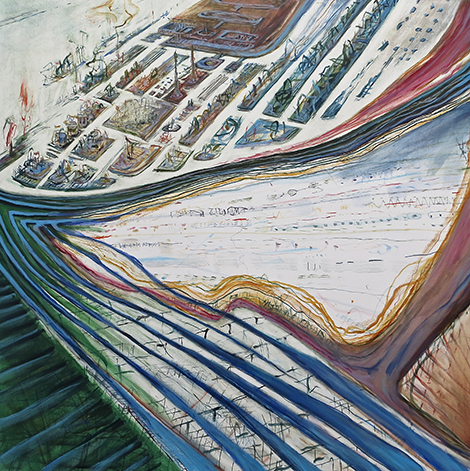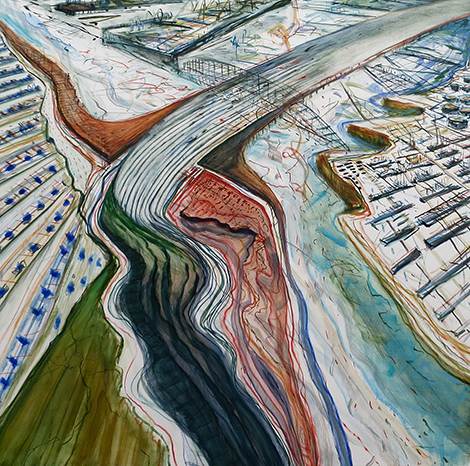While painters are often primarily concerned with light effects and the visual, Berkeley-based Judith Belzer’s work also resonates with a haptic sense. Her imagery is felt in the body, in the hands and feet. Recently awarded a Guggenheim Fellowship, Belzer explores the edge where the natural world interfaces with the industrialized landscape, emphasizing how rhythms and patterns found in nature are echoed in the structures that man has created. An underlying subtext to Belzer’s work is that the “unspoiled” landscape is almost a thing of the past, conveying our anxious energy as we struggle for equilibrium in a world permanently altered by our actions.
Belzer’s early studies were in literature, and her work still reverberates with her love of language, a linear mark-making rooted in text. She first approached organic subject matter through an investigation of the source of paper—trees—creating minutely detailed studies of rotting trunks and exfoliating limbs. Here, concentric rings and striations in the wood assume a monumental significance.
With a sense of shifting from the microcosm to the macrocosm, the artist described how this work engaged her in a fantasy of crawling, like an ant, along the bark of a tree. From her intent observations of the architecture and anatomy of bark, the artist expanded into compositions of densely interwoven branches, which in turn led to explorations of dynamic, invented landscapes—where the man-made structures of factories or freeways intersect with fields or marshes; these have evolved into her current body of work, “Paths of Desire.” The title evokes man’s continual sense of longing and alludes to a term in urban planning for informal shortcuts that evolve in lawns or fields, a crisscrossing where pedestrians or bicycles have taken the quickest route between two points.
Belzer makes her home in the Berkeley hills, where her view of the Bay and shipyards informs her work. Paths of Desire #7 (2014) offers an aerial view; a loosely triangular white shape fills the center of the canvas, and concentric bands rim the shape. Thick, irregular stripes of modulated blues—ultramarine and cobalt—trace a diagonal path below; thin lines of gold rim the interior. Above, small gestural marks, so linear they suggest colored pencil rather than paint and brush, describe a loosely defined industrial area with towers, dilapidated buildings and parking lots. A triangle of washy, dark green paint is broken by transparent, thinly applied blue stripes, her recurring use of this technique drawn from watercolor.
In #3 (2014) a thick stripe like a road, dipping under a bridge, seems to transform into a river, as its wide snaking surface takes an abrupt turn, dropping into a swirling, precipitous green swath. With dynamic, gestural line quality of paint whipping around, and surefooted and energetic areas of deftly applied color, Belzer’s churning and writhing skeins of oil manage to nonetheless convey a formal quality bordering on austere. Visual poems, Belzer’s Paths of Desire lean toward the form of haiku, elegant and spare.



